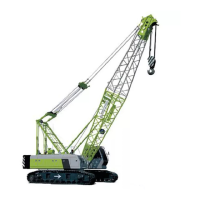起
重
机
说
明
S
a
fe
ty
G
u
i
d
e
l
i
n
e
s
Operator’s Manual for Crawler Crane
Figure 3-74 Control the Tagline
3.5.10 Load center of gravity
a) The center of gravity of an object is the point at which the weight of the object acts as
though it were concentrated. It is the point at which the object may be completely
supported or balanced by a single force.
b) The center of gravity of a regularly shaped object may be estimated fairly accurately by
determining its approximate center.
c) Finding the center of gravity of irregularly-shaped objects can be more difficult, but it is
necessary. A load will always hang from its attachment point through the center of gravity.
It is important to visualize this before making a lift.
d) All loads to be lifted must be rigged above the center of gravity in order to prevent tipping
and possible hazards to equipment and workers. The lifting force must always be located
above the center of gravity and exert a straight vertical pull to prevent swinging of the load.
e) In all crane lifts, the center of gravity must remain below the hook and below the point of
attachment for any rigging.
f) A center of gravity above the hook is unstable and will cause the load to flip as the load will
attempt to ‘find’ the center of gravity. Similarly, loads which are not balanced horizontally
can slip from the rigging.
g) The overall stability of the load is a combination of balance with respect to center of gravity,
distribution of weight, and proper rigging practices.
3.5.11 Sling hook up center of gravity
a) The Center of Gravity (CG) will do at least two things when suspended.
1) Move directly below the point of support.
2) Move to the lowest point possible.
b) Attach the slings above the Center of Gravity of the load. If this is not possible, stabilize the
load and keep the center of gravity contained with three or more sling legs.
3-35

